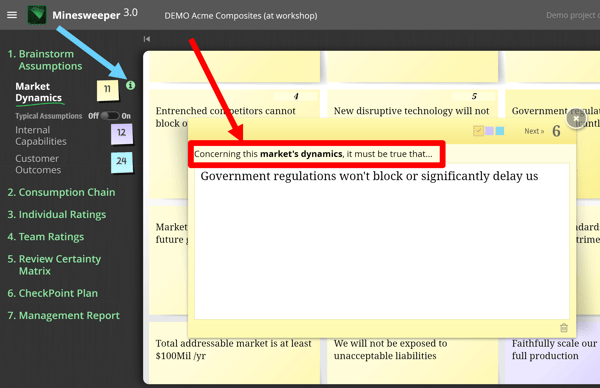Meet with your team to enter assumptions "that must be true" for project success in Minesweeper's sticky notes.
To properly defuse the “landmines” that could kill your project, you must first be aware of them. Sure, you’ll uncover new landmines as your project proceeds. You should always be looking for new potential landmines… assumptions that must be true for your project to succeed. But it’s in your team’s best interest to generate the longest possible list of assumptions at the beginning of your project.
This is the “divergent” phase of project de-risking, and it’s done in two steps: 1) Generate assumptions, and 2) Create a consumption chain to generate even more assumptions. Both of these steps should be done with all members of your team meeting together—in-person or virtually—in a brainstorming session.
Your team will use Minesweeper software for this step, which can be accessed at www.aimclientcenter.com or www.blueprintingcenter.com > Minesweeper tab > Open Minesweeper 3.0. Minesweeper provides “sticky notes” for recording these assumptions, with each sticky note containing a single assumption. These sticky notes are color-coded so your team can group its assumptions into 3 types:
- Market Dynamics (yellow): These are external factors you don’t control, e.g. regulations, market trends & competitive landscape. These would apply for any company pursuing this opportunity.
- Internal Capabilities (purple): These are specific to you as a supplier, e.g. your manufacturing, technical support, etc. If an assumption also involves customer needs, use a blue Customer Outcome sticky note instead of purple. When in doubt, use blue!
- Customer Outcomes (blue): These are customer end-results that are either Required (they must keep getting what they now get) or Desired (they start getting something better). If customers require a minimum performance level but also desire more than this minimum… record both a Required and Desired sticky note.
Here are four tips for recording assumptions in Minesweeper sticky notes.
- Frequently refer to the information icon (“i”) to be sure you’re correctly categorizing your assumptions as yellow Market Dynamics, purple Internal Capabilities, or blue Customer outcomes. (See blue arrow in illustration.) Getting these classifications right sooner than later will save you a good deal of time and confusion.
- Every time you record an assumption, make sure you’re completing the introductory phrase on the sticky note. In the illustration (red arrow), this is “Concerning this market’s dynamics, it must be true that…” Caution: These introductory phrases are different for the purple and blue sticky notes.

- You’ll notice that there are two different types of blue “Customer Outcome” sticky notes: The Required Outcomes are those that customers in this market are already getting… and will want to keep getting. The Desired Outcomes are those you think/hope these customers would like to see improved.
- Make each assumption as brief and clear as possible. You’ll have the opportunity to edit these assumptions later, but it pays to make these “crisp” when you first enter them.
Keywords: generate assumptions, must be true, consumption chain, divergent, Market Dynamics, Internal Capabilities, Customer Outcomes, required outcomes, desired outcomes, sticky note, introductory phrase
